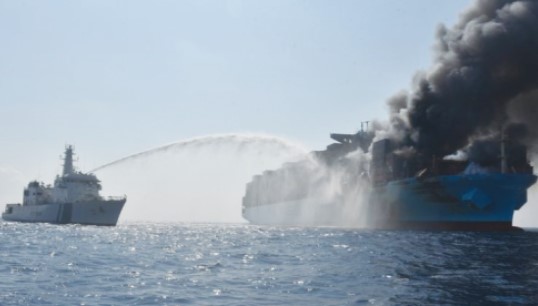- Topics
- Campaigning
- Careers
- Colleges
- Community
- Education and training
- Environment
- Equality
- Federation
- General secretary message
- Government
- Health and safety
- History
- Industrial
- International
- Law
- Members at work
- Nautilus news
- Nautilus partnerships
- Netherlands
- Open days
- Opinion
- Organising
- Podcasts from Nautilus
- Sponsored content
- Switzerland
- Technology
- Ukraine
- United Kingdom
- Welfare
Decomposition dangers surface in Maersk Honam containership fire safety investigation
27 October 2020

A fatal blaze aboard the 153,153gt Maersk Honam has revealed problems with emergency response, concerns over the adequacy of fire-fighting capabilities on containerships and shortcomings in the International Maritime Dangerous Goods (IMDG) Code. Andrew Linington reports
On 6 March 2018, five crew members aboard the Maersk Honam died when a fire swept through the 15,262TEU vessel as it traversed the Arabian Sea. Now an investigation report from the flag state, Singapore, has concluded that the most likely cause was the decomposition of a dangerous cargo being carried in a block of 54 containers in the forepart of the vessel.
In a statement on the findings, Maersk said it was vital that the lessons of the accident are acted upon. 'The magnitude and intensity of this fire made it impossible for any crew to successfully contain, making it key that we as an industry take steps to address the root cause to ensure seafarers never find themselves in a similar situation,' said chief technical officer Palle Laursen.
'We hope this investigation will initiate a more holistic, industry-wide approach where we address the concerns regarding containerised dangerous goods across the entire supply chain – starting at the manufacturing level and following through until the box has been safely delivered at destination to the customer,' he added.
Unidentified instability
The Singapore Transport Safety Investigation Bureau (TSIB) report, which runs to 102 pages, notes that the fire probably started in a block stow of 1,000 tonnes of sodium dichloroisocyanurate dihydrate (SDID). This is a chlorinating agent commonly used for disinfecting water and in the food industry.
Investigators noted that the secondary hazards of chemical decomposition and instability of the substance had not been identified in the IMDG4 Code because SDID is classified under Class 9 of the Code rather than the more stringent Class 5.1 (oxidising substances). However, it has similar chemical properties to Class 5.1 substances, such as calcium hypochlorite – including the potential for self-decomposition when stowed in bulk.
Relatively favourable conditions of carrying out pre-planned drills during daylight hours can set a false sense of accomplishment or illusion amongst the crew, that emergencies could be managed effectively Singapore Transport Safety Investigation Bureau (TSIB) report
The crew's response
The TSIB report also points to several problems with the onboard response to the fire. 'Despite the good efforts demonstrated by the crew in taking care of each other and saving lives during the emergency, it was noted that the fire alarm was not raised at the onset of the event causing a delay in the closure of the magnetic fire doors of the accommodation, and non-closure of exterior ventilation vents,' it states. 'These had resulted in toxic smoke entering and spreading within the accommodation areas.'
Investigations also revealed that the muster list did not clearly identify the roles of everyone onboard, which resulted in some of the crew waiting to be given instructions. In addition, fire-fighting flow charts within the ship emergency response plan did not ensure that all the ventilator flaps/dampers were closed as one of the primary fire-fighting actions, regardless of the location of fire.
Crew members – including a British third officer – abandoned ship two-and-a-half hours after the blaze began. Although the report praises their 'courage and endurance' in trying to tackle the fire, it notes that 'chaos' set in after a series of explosions. Smoke engulfed the accommodation block, toxic gases entered the bridge and the crew split into four separate and dispersed groups.
Investigators warned that the incident highlighted how the 'relatively favourable conditions of carrying out pre-planned drills during daylight hours can set a false sense of accomplishment or illusion amongst the crew, that emergencies could be managed effectively'. The report argues that drills should also be carried out during the hours of darkness, when safe and practical, in recognition of the need for a higher level of preparedness in fire-fighting response and evacuation procedures at night-time.
IMDG Code issues
The report points out that the IMDG Code requirements for SDID failed to recognise its potential thermal instability and permitted it to be stowed under-deck 'where the main fixed fire-fighting system was CO2, which is ineffective to tackle fires associated with such materials'.
It also notes that an effective firefighting response for SDID would have required the use of abundant water, 'which could not have been achieved promptly, given the existing statutory requirements for firefighting measures for container fires under-deck.
'Regardless of amendments to the statutory requirements, dangerous goods with oxidising properties such as SDID should be considered for stowage on-deck, away from direct sunlight, where water could be used more effectively,' it adds.
The TSIB wrote that Maersk has taken several steps to prevent a similar accident and it recommends that the company works with other industry organisations to develop new guidelines for the safe carriage and stowage of SDID.
The report also calls for the flag state to secure a review of the IMDG classification of SDID and to remind operators of the need to load dangerous goods with oxidising properties or self-decomposition risks on deck, away from sunlight and in a location where water can be used more effectively.
It also suggests that emergency drills could be required during the interim audit to identify potential risks at the early stages of a vessel being put into service and that classification societies could develop guidance and additional notations to improve containership fire safety until new goal-based SOLAS Convention standards are agreed.
Tags
